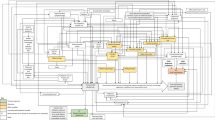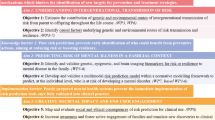Abstract
Asthma is a chronic inflammatory disease of the airways that is highly prevalent in the Western world. It is a genetically complex disease caused by multiple genetic and environmental factors, which may interact. Genetic research has recently incorporated environmental factors to investigate gene by environment interaction, and the first examples of gene by environment interaction in asthma have been reported. Linkage analyses indicate that one or more genes on chromosome 5q interact with environmental tobacco smoke in infancy in asthma development. Several candidate genes have been consistently shown to interact with the environment. These include the innate immunity genes CD14 and Toll-like receptor 4, and microbial exposures, as well as the detoxifying gene family glutathione-S-transferase and environmental tobacco smoke exposure and air pollutants. Gene by environment interaction is important in asthma pathogenesis, and future studies should take the interaction of both factors into account.
Similar content being viewed by others
References and Recommended Reading
Global Initiative for Asthma: Definition. Global initiative for asthma management and prevention, update 2005. NIH Publication No 02-3659. Bethesda, MD: National Institutes of Health; 2005:1–9.
Masoli M, Fabian D, Holt S, Beasly R: The global burden of asthma: executive summary of the GINA Dissemination Committee Report. Allergy 2004, 59:469–478.
Holgate ST: Genetic and environmental interaction in allergy and asthma. J Allergy Clin Immunol 1999, 104:1139–1146.
Upham JW, Holt PG: Environment and development of atopy. Curr Opin Allergy Clin Immunol 2005, 5:167–172.
Hoffjan S, Nicolae D, Ober C: Association studies for asthma and atopic diseases: a comprehensive review of the literature. Respir Res 2003, 4:14. Systematic evaluation of all published association analyses in asthma genetics.
Ober C, Thompson EE: Rethinking genetic models of asthma: the role of environmental modifiers. Curr Opin Immunol 2005, 17:670–678. Interesting review that illustrates different concepts of gene by environment interaction and proposes to study epigenetic mechanisms.
Bottema RW, Reijmerink NE, Koppelman GH, et al.: Phenotype Definition, age, and gender in the genetics of asthma and atopy. Immunol Allergy Clin North Am 2005, 25:621–639.
Van Eerdewegh P, Little RD, Dupuis J, et al.: Association of the ADAM33 gene with asthma and bronchial hyperresponsiveness. Nature 2002, 418:426–430. First report of the identification of a novel gene for asthma using positional cloning.
Blakey J, Halapi E, Bjornsdottir US, et al.: Contribution of ADAM33 polymorphisms to the population risk of asthma. Thorax 2005, 60:274–276.
Allen M, Heinzmann A, Noguchi E, et al.: Positional cloning of a novel gene influencing asthma from chromosome 2q14. Nat Genet 2003, 35:258–263.
Zhang Y, Leaves NI, Anderson GG, et al.: Positional cloning of a quantitative trait locus on chromosome 13q14 that influences immunoglobulin E levels and asthma. Nat Genet 2003, 34:181–186.
Nicolae D, Cox NJ, Lester LA, et al.: Fine mapping and positional candidate studies identify HLA-G as an asthma susceptibility gene on chromosome 6p21. Am J Hum Genet 2005, 76:349–357.
Noguchi E, Yokouchi Y, Zhang J, et al.: Positional identi fication of an asthma susceptibility gene on human chromosome 5q33. Am J Respir Crit Care Med 2005, 172:183–188.
Laitinen T, Polvi A, Rydman P, et al.: Characterization of a common susceptibility locus for asthma-related traits. Science 2004, 304:300–304.
Kormann MS, Carr D, Klopp N, et al.: G-protein-coupled receptor polymorphisms are associated with asthma in a large German population. Am J Respir Crit Care Med 2005, 171:1358–1362.
Khoury MJ, Davis R, Gwinn M, et al.: Do we need genomic research for the prevention of common diseases with environmental causes? Am J Epidemiol 2005, 161:799–805. Concise discussion on potential public health benefits of the detection of gene-environment interaction.
Strachan DP, Cook DG: Health effects of passive smoking. 6. Parental smoking and childhood asthma: longitudinal and case-control studies. Thorax 1998, 53:204–212.
Colilla S, Nicolae D, Pluzhnikov A, et al.: Evidence for gene-environment interactions in a linkage study of asthma and smoking exposure. J Allergy Clin Immunol 2003, 111:840–846.
Meyers DA, Postma DS, Stine OC, et al.: Genome screen for asthma and bronchial hyperresponsiveness: interactions with passive smoke exposure. J Allergy Clin Immunol 2005, 115:1169–1175. Reports strong effects of environmental tobacco smoke exposure on linkage results of asthma and bronchial hyperresponsiveness.
Choudhry S, Avila PC, Nazario S, et al.: CD14 tobacco gene-environment interaction modifies asthma severity and immunoglobulin E levels in Latinos with asthma. Am J Respir Crit Care Med 2005, 172:173–182.
Gilliland FD, Li YF, Dubeau L, et al.: Effects of glutathione S-transferase M1, maternal smoking during pregnancy, and environmental tobacco smoke on asthma and wheezing in children. Am J Respir Crit Care Med 2002, 166:457–463.
Kabesch M, Hoefler C, Carr D, et al.: Glutathione S transferase deficiency and passive smoking increase childhood asthma. Thorax 2004, 59:569–573. Candidate gene study on glutathione-S-transferase genes and environmental tobacco smoke interaction in a large cohort of German schoolchildren.
Lee YL, Lin YC, Lee YC, et al.: Glutathione S-transferase P1 gene polymorphism and air pollution as interactive risk factors for childhood asthma. Clin Exp Allergy 2004, 34:1707–1713.
Gilliland FD, Li YF, Saxon A, Diaz-Sanchez D: Effect of glutathione-S-transferase M1 and P1 genotypes on xenobiotic enhancement of allergic responses: randomised, placebo-controlled crossover study. Lancet 2004, 363:119–125. Elegant experiment to show gene by environment interaction in atopy severity.
Fryer AA, Bianco A, Hepple M, et al.: Polymorphism at the glutathione S-transferase GSTP1 locus: a new marker for bronchial hyperresponsiveness and asthma. Am J Respir Crit Care Med 2000, 161:1437–1442.
Vercelli D: Innate immunity: sensing the environment and regulating the regulators. Curr Opin Allergy Clin Immunol 2003, 3:343–346.
Strachan DP: Family size, infection and atopy: the first decade of the "hygiene hypothesis." Thorax 2000, 55(Suppl 1):S2-S10.
Braun-Fahrlander C, Riedler J, Herz U, et al.: Environmental exposure to endotoxin and its relation to asthma in school-age children. N Engl J Med 2002, 347:869–877.
LeVan TD, Bloom JW, Bailey TJ, et al.: A common single nucleotide polymorphism in the CD14 promoter decreases the affinity of Sp protein binding and enhances transcriptional activity. J Immunol 2001, 167:5838–5844.
Koppelman GH, Postma DS: The genetics of CD14 in allergic disease. Curr Opin Allergy Clin Immunol 2003, 3:347–352.
Ober C, Tsalenko A, Parry R, Cox NJ: A second-generation genomewide screen for asthma-susceptibility alleles in a founder population. Am J Hum Genet 2000, 67:1154–1162.
Kedda MA, Lose F, Duffy D, et al.: The CD14 C-159T polymorphism is not associated with asthma or asthma severity in an Australian adult population. Thorax 2005, 60:211–214.
Vercelli D: Learning from discrepancies: CD14 polymorphisms, atopy and the endotoxin switch. Clin Exp Allergy 2003, 33:153–155. Original hypothesis to explain dual effects of endotoxin levels in the environment to explain differences in results of genetic association studies of CD14.
Eder W, Klimecki W, Yu L, et al.: Opposite effects of CD 14/-260 on serum IgE levels in children raised in different environments. J Allergy Clin Immunol 2005, 116:601–607.
Gern JE, Reardon CL, Hoffjan S, et al.: Effects of dog ownership and genotype on immune development and atopy in infancy. J Allergy Clin Immunol 2004, 113:307–314.
Zambelli-Weiner A, Ehrlich E, Stockton ML, et al.: Evaluation of the CD14/-260 polymorphism and house dust endotoxin exposure in the Barbados Asthma Genetics Study. J Allergy Clin Immunol 2005, 115:1203–1209. Observational study on severity of asthma and endotoxin levels showing dual effects of CD14 genotype.
Arbour NC, Lorenz E, Schutte BC, et al.: TLR4 mutations are associated with endotoxin hyporesponsiveness in humans. Nat Genet 2000, 25:187–191.
Werner M, Topp R, Wimmer K, et al.: TLR4 gene variants modify endotoxin effects on asthma. J Allergy Clin Immunol 2003, 112:323–330.
Eder W, Klimecki W, Yu L, et al.: Toll-like receptor 2 as a major gene for asthma in children of European farmers. J Allergy Clin Immunol 2004, 113:482–488.
Matricardi PM, Rosmini F, Ferrigno L, et al.: Cross sectional retrospective study of prevalence of atopy among Italian military students with antibodies against hepatitis A virus. BMJ 1997, 314:999–1003.
McIntire JJ, Umetsu SE, Macaubas C, et al.: Immunology: hepatitis A virus link to atopic disease. Nature 2003, 425:576. Provides interesting data on a potential mechanism of hepatitis A infection and atopy development.
Graves PE, Siroux V, Guerra S, Klimecki WT, Martinez FD: Association of atopy and eczema with polymorphisms in T-cell immunoglobulin domain and mucin domain-IL-2-inducible T-cell kinase gene cluster in chromosome 5 q 33. J Allergy Clin Immunol 2005, 116(3):650–656.
Collins FS: The case for a US prospective cohort study of genes and environment. Nature 2004, 429(6990):475–477.
Altshuler D, Brooks LD, Chakravarti A, et al.: A haplotype map of the human genome. Nature 2005, 437:1299–1320. Recent report of the novel HAPMAP data, a catalogue of human genetic variation.
Nagy A, Kozma GT, Keszei M, et al.: The development of asthma in children infected with Chlamydia pneumoniae is dependent on the modifying effect of mannose-binding lectin. J Allergy Clin Immunol 2003, 112:729–734.
Hoffjan S, Nicolae D, Ostrovnaya I, et al.: Gene-environment interaction effects on the development of immune responses in the 1st year of life. Am J Hum Genet 2005, 76:696–704.
Liu X, Beaty TH, Deindl P, et al.: Associations between specific serum IgE response and 6 variants within the genes IL4, IL13, and IL4RA in German children: the German Multicenter Atopy Study. J Allergy Clin Immunol 2004, 113:489–495.
Wang Z, Chen C, Niu T, et al.: Association of asthma with beta(2)-adrenergic receptor gene polymorphism and cigarette smoking. Am J Respir Crit Care Med 2001, 163:1404–1409.
Liu X, Beaty TH, Deindl P, et al.: Associations between total serum IgE levels and the 6 potentially functional variants within the genes IL4, IL13, and IL4RA in German children: the German Multicenter Atopy Study. J Allergy Clin Immunol 2003, 112:382–388.
Barr RG, Cooper DM, Speizer FE, et al.: Beta(2)-adrenoceptor polymorphism and body mass index are associated with adult-onset asthma in sedentary but not active women. Chest 2001, 120:1474–1479.
Author information
Authors and Affiliations
Corresponding author
Rights and permissions
About this article
Cite this article
Koppelman, G.H. Gene by environment interaction in asthma. Curr Allergy Asthma Rep 6, 103–111 (2006). https://doi.org/10.1007/s11882-006-0047-y
Issue Date:
DOI: https://doi.org/10.1007/s11882-006-0047-y




